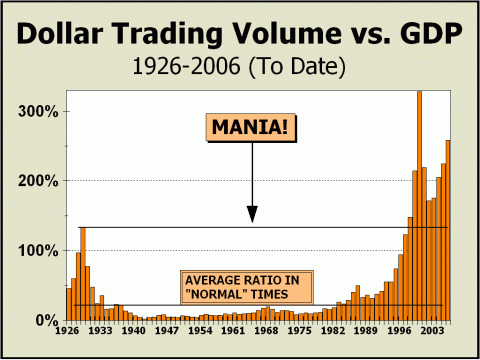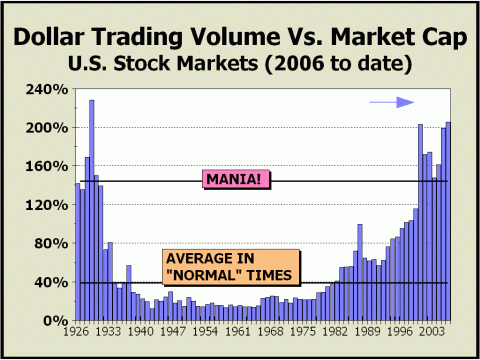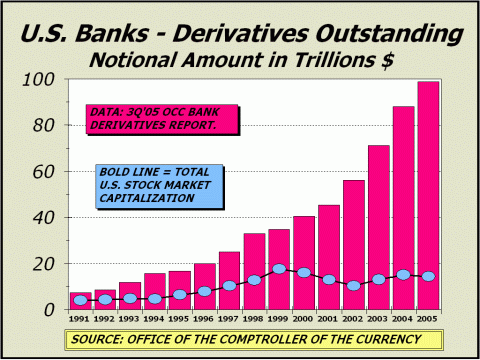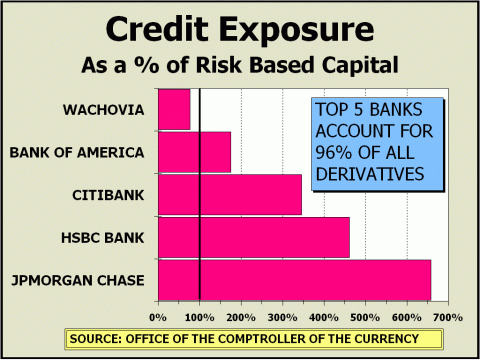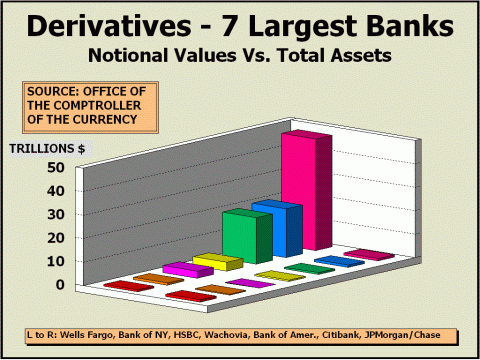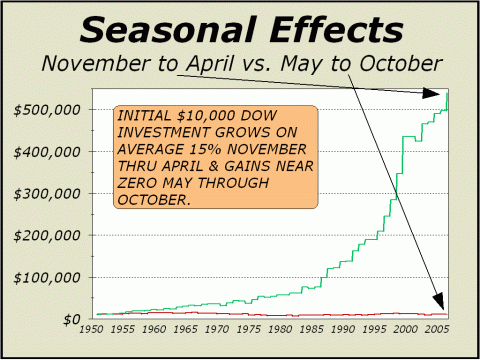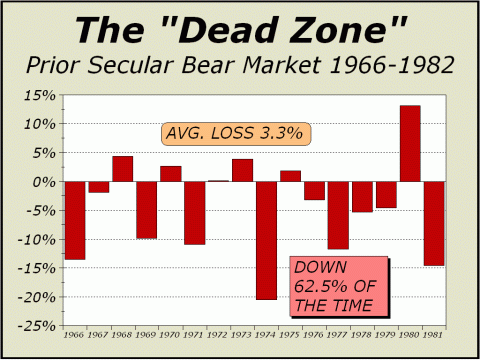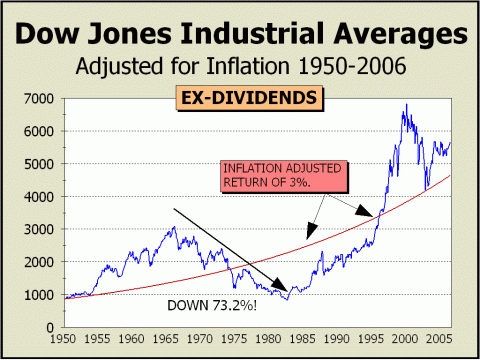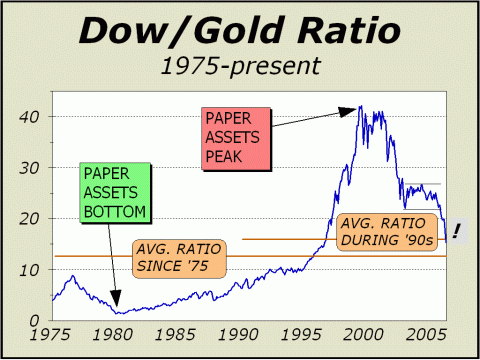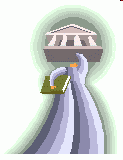
|
- THE GREATEST STOCK MARKET MANIA OF ALL TIME - DATED MAY 26, 2006 A SPECIAL REPORT BY ALAN M. NEWMAN, EDITOR CROSSCURRENTS This feature is now published on a quarterly basis. Our next update will not be published until late August or early September 2006. |
| This is our
53rd report on the ongoing mania since we first published this website
on January 15, 1999. Well over three million visitors have read our
free features and well over one million visitors have visited this particular
page.
A world map of our readers from 76 countries can be viewed HERE. Run your mouse over each country! This report is now mostly a compilation of articles that have previously appeared in the Crosscurrents newsletter. Our paid subscription stock market newsletter has only two rationales for its existence; powerful commentary and unique perspectives that cannot be found anywhere else. Please check out the testimonials on our Kudos page. To purchase a printable file of this report for $10, please CLICK HERE
The only circumstance that sets the present environment apart from the absurd peak in 2000 is that Gross Domestic Product has expanded by roughly 35% since then. The economy is substantially larger and apparently can continue to support an ongoing mania for the present. At the March 2000 peak, GDP was less than $10 trillion. GDP is now more than $13 trillion. But the real news as far as we are concerned is that Dollar Trading Volume is now on track to set another brand new all time record. That's right, higher than ever before. Dollar Trading Volume in 2000
= $32.65 trillion
Our first chart tells you all you really need to know about U.S. stocks. The mania never ended and merely took a time out. It is certainly worth mentioning that when DTV measured 133% of GDP in 1929, a mania drove public participation. The same was clearly true in 1999 and 2000, when stocks traded 328% of GDP. What can we make of the situation today, when stocks are trading at a pace that is 258% of GDP, nearly double the pace in 1929?! Not only are we still in the
midst of a mania,
We also measure Dollar Trading Volume versus total stock market capitalization. Incredibly, at the current pace, we will exceed trading in 2000 relative to market cap. This is hugely significant because total market cap was nearly 8% higher in 2000 and was close to 13% higher at the March 2000 highs. This means that no lessons
were learned in the
This means that fear is no
longer
Greed has overcome fear.
$99 Trillion And Still Counting WHILE
WE'RE ON THE SUBJECT OF A MANIA, HERE'S YET ANOTHER MANIA,
THIS IS THE FULL ARTICLE THAT ORIGINALLY RAN IN THE FEBRUARY 27, 2005 ISSUE OF CROSSCURRENTS Subscribers have access to our newsletter archives and are advised to check out the June 20, 2005 issue ("Well, Not Really") for what was possibly our strongest commentary of the year. It's been that long since we covered the derivative scene in print, and high time that we did again. The charts presented today are created from data through the third quarter of 2005, so this is not even a glimpse of year end activity. Still, it's another brand new record and by a lot. Total notional values in derivatives for U.S. banks increased at least 12.4% last year to just under $99 trillion. That's right, trillion, 99 followed by 12 zeroes. The phenomenal growth in derivatives dwarfs the stratospheric rise of the major stock averages into the mania’s peak. Notional values have nearly tripled since the end of 1999 and are 6.9 times the size of total stock market capitalization, versus less than double market cap six years ago.
The first year we have data for is 1991, when notional values were only $7.3 trillion. Since then, average annualized growth has been an amazing 20.4%. Growth barely slowed in the last six years to 19% and bear in mind, the fourth quarter of 2005 still hasn't been reported. At the end of 1999, ten weeks before the stratospheric blowoff in Nasdaq, notional values were 3.7 times the size of Gross Domestic Product. They are now 7.8 times GDP. As the Long Term Capital Management fiasco showed in the fall of 1998, growth in derivatives has far outpaced our ability to monitor the size and effectiveness all derivative instruments. Although risks for one party are typically counterbalanced by an offset for the party on the other side of the transaction, risks cannot be laid off in perpetuity. Somewhere along the line, the risk of the transaction must be borne - if necessary, by the market (read the financial system). As we have maintain so many times before, systemic risks cannot be totally arbitraged away by counter parties or otherwise removed entirely from the system. GM' s $30 billion in debt is linked to about $200 billion in derivatives (see http://tinyurl.com/fk3k6). As Henry Sender's WSJ article states, "But because such derivatives don't trade on an exchange, nobody knows for certain how much credit-default swap protection has actually been written on GM. And nobody can say with confidence that they even know who is on the other side of the trades that they have entered into." If GM defaults in a bankruptcy, someone is going to get screwed. As noted by Goldman Sach's E. Gerald Corrigan, "One of the areas that needs watching is that the volume or value of deliverable bonds is smaller than the value of the potential claims." If only 1% of the total of $98.78 trillion in derivatives represents real credit risk in a worst case scenario, the potential fall out of nearly $1 trillion has the capability to collapse the entire financial system. Clearly, we came close in 1998. The Fed was forced to “invite” all the major banks and brokers to a closed door meeting (see When Genius Failed: The Rise and Fall of Long-Term Capital Management by Roger Loewenstein - ISBN 037550317X) in order to plan a $3.6 bailout to save the hedge fund. As Publisher's Weekly surmised, ".... questions arose about why usually independent banks would band together to save a single privately held fund. The short answer is that the banks feared that the fund's collapse could destabilize the entire stock market."
It is with some measure of alarm that we report the derivative market is now three times the size it was when LTCM ruptured. The ten-sigma event that led to the near collapse was inevitable. Despite the apparent "safety" of extremely low odds events, the passage of time always assures they will occur! In the June 20, 2005 issue, we related how GLG Partners suffered hugely when an eight standard deviation event disrupted a trading model. The odds of the event were so rare that the model claimed the consequences could be ignored. Ignored? One look at the chart below should be sufficient to question how worst case scenario consequences could ever be ignored, no matter how remote the possibility. Essentially, 96% of derivatives are suffering an average credit exposure of 343% of risk based capital.
The picture of notional values vs. total assets is equally disturbing. Perhaps giant JPMorganChase considers the company adequately hedged on all transactions (and we're certain they do), but as LTCM and GLG and countless others in the last decade showed, worst case scenarios and extremely low odds events do occur and they occur all too often. We can only wonder where derivative growth may be headed. Ten times market cap and GDP? Twenty times? What will happen when the inevitable $100 billion blow up occurs? Can the Fed broker a deal that large? More importantly, will we ever see total transparency in the market? As Henry Sender's quote in the third paragraph of this article clearly implies, if ".... nobody can say with confidence that they even know who is on the other side of the trades that they have entered into," then clearly, no entity can ever be in a position of totally avoiding risk. The risks are huge and they are growing every day.
The Dead Zone (Reprised) FROM THE APRIL 24, 2005 ISSUE OF CROSSCURRENTS Twice each year, we examine a most unusual phenomenon that has ruled the stock market for well over 50 years. Simply put, virtually all of the price gains in stocks have come during the months from November through April. The phenomenon has been written about extensively by Yale Hirsch, Norman Fosback, Sy Harding and your Editor, who first covered what we call the "Dead Zone," perhaps 15 years ago. In chapter seven of his book, Riding the Bear (ISBN: 1-58062-154-6), Harding describes the seasonal phenomenon in depth. The chapter is titled, "The Best Mechanical System Ever" and the author even shows how, with a few logical and tiny tweaks, the seasonal effects would have generated fantastic gains. Harding graciously included your Editor's own research, which confirmed this most amazing dichotomy. Since 1950, from May through October, you might as well have put your money under the mattress and you would clearly have been better off in a simple bank savings account. The statistics are indisputable. Measured via the Dow Industrials, if you had invested $10,000 in stocks solely during the period from November through April each year since 1950, you would now have nearly $540,000. However, if you had done the same solely from May through October each year, you would now have a mere $10,549. The good six months generated a 15% return, whereas the bad six months generated a tick more than nothing. And consider the following; inflation would have taken a harrowing toll on any monies invested in the Dow solely from May through October since 1950, a stake of $10,000 would be worth less than $1300 today, measured in 1950 dollars!
Our featured chart illustrates the seasonal dichotomy with astonishing clarity. Is there any doubt at all that stocks have not been for all seasons, in contrast to what Wall Street would have you believe? Even more distressing is the tally of returns during a secular bear market, like the one that endured from 1966 to 1982 (see page two, chart at bottom left). Although the so-called "Nifty Fifty" did indeed go on to record gains into the end of 1972, the Dow topped out at just over 1000 for the first time in 1966 and was only a few points higher at the January 1973 peak (and didn't pass the 1000 mark for good until 1982). Most stocks had seen their peak a half dozen years earlier. Then, from 1966 to 1982, even the good six months averaged only a 4.5% upside. During the Dead Zone, prices declined by an average of 3.3%. Our chart amply illustrates just how investors suffered during the stock market's weak season in the last secular bear market lasting 16 years, a total of 56% in nominal terms.
Dead Zone returns actually peaked in October 1965, more than 40 years ago! Over the last four decades, the Dow has declined by roughly 33% during the Dead Zone! Adjust those results for inflation and the decline becomes a staggering 89%! Is it not amusing that Wall Street covers up this phenomenon?*** Considering our next chart at bottom right, we can only wonder why inflation is not a more well considered factor when viewing the longer term prospects for stocks. Clearly, inflation adjusted returns were under 3% for a very long time, March 1974 to January 1996 - a span of 21 years 10 months! If returns could stay that low for so long, they can certainly return to those levels. Ironically, if that same 3% inflation adjusted return was indeed achieved this year, the Dow would trade about 18% lower, precisely in line with our forecast of a high probability of a 15%-20% correction this year! Chalk up more credibility for our forecast.
Will the Dead Zone continue to work? We cannot say with complete certainty, but the apparent reasons why the seasonal phenomenon exists have not changed. January and April have been the best months for stocks for as long as we can remember and it is obvious that the primary reason is that mutual fund inflows have been the highest in those two months. In our next issue dated May 8th, we will examine these factors again in depth. Stay tuned. ***Since this statistic is so sensational, we should probably back it up with the math. Our theoretical $10,000 invested solely in the Dead Zone period in 1950 peaked at $15,159.89 in October 1965. The CPI then stood at 31.7. The CPI as of last October was 199.2. Thus, inflation had eaten away all but 15.9% of the 1965 dollar (31.7/199.2=15.9%) and the Dead Zone investment is only worth roughly two-thirds in nominal dollars what it was worth in 1965. Multiply 67% by 15.9% and the result is 11% of the original investment, equating to an 89% decline in purchasing power.
Thus, not only are we still in a mania, we are still in an environment where seemingly no one is concerned about the historical record that amply illustrates no money has been made between May and November in the last 55 years. Complacency on a startling scale!
The
Great Paper Chase Is Ending
Demand for hard assets in the future could be staggering. The chart of the Dow/Gold ratio below illustrates the shift from paper assets is clearly underway. “Resistance” at the prior low of 22-1 in February 2003 was broken so conclusively and substantially that we can only infer a super bull market is now in place. This ratio averaged 16.08 during the decade of the 90s and has averaged 12.77 since 1975. The ratio is now 19.08 and if we are correct, has much further to go. We believe the two aforementioned ratios will be tested in the next few years to come and we should eventually expect a return of the levels experienced before the mania for stocks commenced, at least a 10 to 1 ratio. Since our worst case scenario for stocks is now the 5% regression line for the Dow (see the January 9, 2005 issue of Crosscurrents), we can easily extrapolate the possibilities for Gold. Bear in mind our low target for the Dow will increase at 5% per year from 8483 this year to 10,827 in five years. A Dow/Gold ratio of 15-1 would place a worst case for bullion between $565 to $722 per ounce. A Dow/Gold ratio of 10-1 would place a much better case for bullion between $848 to $1083 per ounce. What if the Dow trades higher? That would mean even higher gold prices. Interestingly, in our view, these are modest extrapolations. Given gold’s volatile past, a 10-1 Dow/Gold ratio may severely understate the case for hard assets. If it is a super bull market, practically anything is possible.
IF YOU WISH TO SEE THE ENTIRE
ARTICLE, PLEASE CONTACT US
Six years later, nothing has been learned from the 45% collapse in prices from 2000 to 2002. Dollar Trading Volume is on pace to establish a brand new record high. But the many commodities bull markets are ample evidence that the great paper chase is in the process of ending. The greatest stock market mania of all time is ending.
We have now established a new secondary secular bear market low target of no lower than Dow 8000 and more likely, Dow 8500. These levels equate to SPX 980/995 & Nasdaq 1750/1775. Caveat: these levels could be achieved several times in the next few years and it might be another decade before a new secular bull market is capable of taking all of the major averages above the peak achieved in 2000. While the Dow clearly maintains the best chance of achieving new highs, the SPX is still 23% away and Nasdaq is 134% from the all time highs.
High
Targets for 2006
Low
Targets for 2006
Odds favor that the highs for 2006 have already been achieved THE CONTENTS OF THE ENTIRE WEBSITE ARE COPYRIGHT 2006 CROSSCURRENTS PUBLICATIONS, LLC I hope you have enjoyed your visit and please return again. If you know anyone who might be interested in seeing what we have to offer, we'd be happy to have them visit as well! Alan M. Newman, May 26, 2006 All information on this website is prepared from data obtained from sources believed reliable, but not guaranteed by us, and is not considered to be all inclusive. Any stocks, sectors or indexes mentioned on this page are not to be construed as buy, sell, hold or short recommendations. This report is for informational and entertainment purposes only. Persons affiliated with Crosscurrents Publications, LLC may be long or short the securities or related options or other derivative securities mentioned in this report. Our perspectives are subject to change without notice. We assume no responsibility or liability for the information contained in this report. No investment or trading advice whatsoever is implied by our commentary, coverage or charts. |
